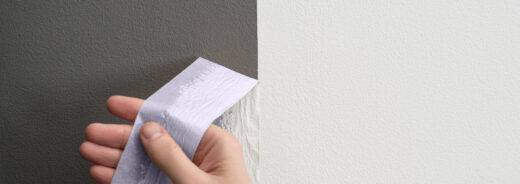
When planning home construction or renovation work, we can’t manage without a wide range of tapes such as reinforced plastering tape, adhesive aluminium foil tape, caulk sealing tape, glass cloth tape, painter’s tape. Before you begin painting, you have to decide which tape to use — masking tape or painter’s tape. So, how to make the best possible decision and what questions to raise before picking up a brush or a roller?
It depends on the type of work
The first question you’ll have to find an answer to when choosing tapes for painting jobs is what kind of work is to be performed. For simple and smaller painting projects that do not require precision, masking tape is often sufficient, and it is usually much cheaper. It also adheres well to protective paper, protects the surrounding area when painting various objects or walls, and is the ideal solution for leaving an unpainted line on the wall. The colour of the tape is also important here — if the wall is being painted white, it is better to go for yellow tape so you can see where the paint has already been applied. If you are painting in a bright colour, you might consider white tape.
Another important aspect to consider is where the work is to be performed. For example, some tapes of the Zoom brand are better suited for interior painting work, such as covering door frames or window frames without leaving adhesive traces on the surfaces. In contrast, Zoom Outdoor tapes adhere well to metal, glass, plastic and plastered surfaces, and being more versatile can be used for outdoor application.
Don’t do the same job twice
If more complex and delicate work is planned indoors or outdoors, and if the surfaces are more sensitive, painter’s tape is a must. This warning should be heeded — when using masking tapes, which have a much stronger adhesive, you can eventually peel off not only the paint, but also the putty or surface that has been prepared for painting, together with the tapes themselves. In general, experts advise always choosing the tape with the lowest possible adhesion if you don’t want to do the same job twice. They also have a straight line, a sharp tape cutting angle and a well-impregnated surface that doesn’t let the paint seep through.
Prior to choosing from a range of painters’ tapes, it is important to answer the question on what surface they will be applied. Also, how long will the paint job take? Once you have found the answers, it is worth looking at the information on the product packaging about the intended use, resistance to environmental exposure and suitability for the paint category.
A solution for extremely sensitive surfaces

For more experienced painters, the Zoom brand’s Sensitive PLUS and Precision painter’s tapes are recommended. The latter not only ensure a straight, perfect paint edge, but also are more versatile and can be used not only for sensitive surfaces but also for exterior applications. Precision tapes can stay up to three months when applied outdoors and are valued by exterior painting experts for their ability to withstand temperatures of up to 125 degrees, which can be reached on surfaces exposed to the sun.
The acrylic-coated painter’s tapes of the Sensitive PLUS series are designed for more sensitive, already-painted surfaces, to protect them from peeling off when the work is finished. Not only do they leave no adhesive residue, but these painter’s tapes are solvent-, moisture- and UV-resistant, so they can be left on sensitive surfaces for up to a week, both indoors and out.
The improved Sensitive PLUS painter’s tapes, launched at the beginning of this year, are designed for even more sensitive surfaces. Like the Precision painter’s tapes, Sensitive PLUS tapes are made from a special Japanese Washi paper, which is traditionally produced and treated by hand, and is praised for its flexibility and sharp paper cutting angle.